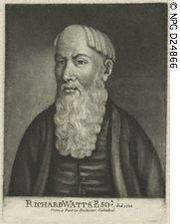
Richard Watts
Encyclopedia

Kent
Kent is a county in southeast England, and is one of the home counties. It borders East Sussex, Surrey and Greater London and has a defined boundary with Essex in the middle of the Thames Estuary. The ceremonial county boundaries of Kent include the shire county of Kent and the unitary borough of...
in the 1570s. He supplied rations for the English Navy as deputy victualler and supervised the construction of Upnor Castle
Upnor Castle
Upnor Castle is an Elizabethan artillery fort located in the village of Upnor, Kent, England. Its purpose was to defend ships moored "in ordinary" on the River Medway outside Chatham dockyards....
. Famed locally for his philanthropy, he left money in his will to establish the Richard Watts Charity and Six Poor Travellers House in Rochester High Street.
Six Poor Travellers HouseSix Poor Travellers HouseSix Poor Travellers House is a 16th-century charity house in Rochester, Kent, founded by the local MP Richard Watts to provide free lodgings for poor travellers...
Watts left money in his will for the benefit of six poor travellers, each of whom, according to a plaque on the outside of the building, would be given lodging and 'entertainment' for one night, before being sent on their way with fourpence.The house was the inspiration for Charles Dickens
Charles Dickens
Charles John Huffam Dickens was an English novelist, generally considered the greatest of the Victorian period. Dickens enjoyed a wider popularity and fame than had any previous author during his lifetime, and he remains popular, having been responsible for some of English literature's most iconic...
' short story, The Seven Poor Travellers. Watts' benevolence and the Dickens story are remembered during Rochester's fancy dress Dickensian Christmas Festival, when a turkey is cooked and ceremoniously distributed to 'the poor' at the house.
Henry Lucy
Henry Lucy
Sir Henry Lucy JP, was an English journalist and humorist, and a parliamentary sketch-writer acknowledged as the first great lobby correspondent....
described a visit to the house in "Christmas Eve at Watts's" in Faces and Places and throws an interesting light on Dickens' story, through the words of the house-keeper.
There is also a very detailed account of Richard Watts's Charity, Rochester in Chapter VI of A Week's Tramp in Dickens-Land, by William R. Hughes.
Watts Almshouses
Watts' legacy was so substantial that a charity bearing his name is still in existence today. The Watts Almshouses, administered by the charity, on Rochester's Maidstone Road, are a fine example of Victorian gothicGothic Revival architecture
The Gothic Revival is an architectural movement that began in the 1740s in England...
cottagery.
Satis House
Queen Elizabeth I was the guest of Sir Richard Watts in 1573. When he asked her if his house was to her liking, she replied 'Satis' (Latin for 'enough'). The house was thereafter known as 'Satis House'. Satis House is now the administrative building for The King's School, RochesterThe King's School, Rochester
The King's School, Rochester is an independent school in Rochester, Kent. It is a cathedral school, and being part of the foundation of Rochester Cathedral, the Dean of Rochester Cathedral serves as the chair of the school's governing body...
. A bust of Watts has been set on top of the building's portico. Dickens used the name Satis House for Miss Havisham's house in his novel, Great Expectations
Great Expectations
Great Expectations is a novel by Charles Dickens. It was first published in serial form in the publication All the Year Round from 1 December 1860 to August 1861. It has been adapted for stage and screen over 250 times....
, although other aspects of the fictitious Satis House were modelled on nearby Restoration House
Restoration house
Restoration House in Rochester, Kent, England, is a fine example of an Elizabethan mansion. It is so named because King Charles II stayed there in 1660 on his way to reclaim England's throne, an event known as the Restoration....
.

